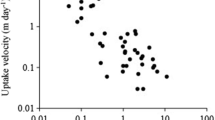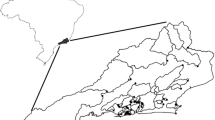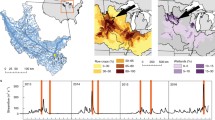Abstract
Since mean nitrate concentration along single river channels increases significantly with percent arable land use upstream of sampling points and autumn/early winter flushes in nitrate concentration are widespread, it is generally concluded that farmers contribute most of the nitrate. For the River Derwent in North Yorkshire, the correlation between nitrate concentration and percent arable land use is much poorer when tributary data are included in the equation, because of greater variations in dilution by water draining upland areas and in other N input sources. For the whole river system therefore, percent upland moorland/rough grazing land cover is an appreciably better predictor than percent arable land use for nitrate concentration. Upland land use encompasses the higher precipitation and runoff in such areas, and the subsequent greater dilution downstream of both arable land runoff and effluent from treatment works, as well as an inverse correlation to percent arable land use. This is strongly supported by the observation that, for the Derwent, Meteorological Office rainfall data alone proved even better than percent moorland rough grazing for predicting nitrate concentration. The dilution effect is therefore substantial but highly seasonal; lower runoff and dilution in summer offset the lower leaching losses from arable land, and higher dilution and runoff in winter offset greater nitrate leaching losses from arable soils. Because of this, coupled to improved efficiency of nitrogen fertilizer use, seasonality trends in nitrate concentrations that were pronounced a decade ago now have all but disappeared in the catchment.






Similar content being viewed by others
References
Barnes, A. P., Willock, J., Hall, C., & Toma, L. (2009). Farmer perspectives and practices regarding water pollution control programmes in Scotland. Agricultural Water Management, 96, 1715–1722.
Clark, M. J., Cresser, M. S., Smart, R., Chapman, P. J., & Edwards, A. C. (2004). The influence of catchment characteristics on the seasonality of carbon and nitrogen species concentrations in upland rivers of Northern Scotland. Biogeochemistry, 68, 1–19.
Cresser, M. S., Begum, S. & Bhatti, A. (2011). Causes of losses of seasonal trends in nitrate concentration in some UK rivers, IWA Specialist Group on Diffuse Pollution Newsletter, No. 32, 20. http://www.iwahq.org/Home/Networks/Specialist_groups/List_of_groups/Diffuse_Pollution. Accessed 28 Feb 2012
Cresser, M. S., Smart, R. P., Clark, M., Crowe, A., Holden, D., Chapman, P. J., & Edwards, A. C. (2004). Controls on N species leaching in upland moorland catchments. Water, Air, & Soil Pollution: Focus, 4, 85–95.
DEFRA (2002). The government’s strategic review of diffuse water pollution from agriculture in England: agriculture and water: a diffuse pollution review. June 2002, 85 pp.
Edwards, A. C., Cook, Y., Smart, R. P., & Wade, A. J. (2000). Concentrations of nitrogen and phosphorus in streams draining the mixed land-use dee catchment, north-East Scotland. Journal of Applied Ecology, 37(1), 159–170.
Ferrier, R. C., Edwards, A. C., Hurst, D., Littlewood, I. G., Watts, C. D., & Morris, R. (2001). Water quality of Scottish rivers: spatial and temporal trends. Science of the Total Environment, 265(1–3), 327–342.
Heathwaite, A. L., Burt, T. P., & Trudgill, S. T. (1993). Overview—the nitrate issue. In T. P. Burt, A. L. Heathwaite, & S. T. Trudgill (Eds.), Nitrate: processes, patterns and management (pp. 3–21). Chichester: Wiley.
Helliwell, R. C., Coull, M. C., Davies, J. J. L., Evans, C. D., Norris, D., Ferrier, R. C.′., Jenkins, A., & Reynolds, B. (2007). The role of catchment characteristics in determining surface water nitrogen in four upland regions in the UK. Hydrology and Earth System Sciences, 11, 356–371.
Holloway, J. M., Dahlgren, R. A., Hansen, B., & Casey, W. H. (1998). Contribution of bedrock nitrogen to high nitrate concentrations in stream water. Nature, 395, 785–788.
Hutchins, M. G., Deflandre-Vlandas, A., Posen, P. E., Davies, H. N., & Neal, C. (2010). How do river nitrate concentrations respond to changes in land-use? A modeling case study of headwaters in the River Derwent catchment, North Yorkshire, UK. Environmental Modeling and Assessment, 15, 93–109.
Jarvie, H. P., Oguchi, T., & Neal, C. (2002). Exploring the linkages between river water chemistry and watershed characteristics using GIS-based catchment and locality analyses. Regional Environmental Change, 3, 36–50.
Kernan, M. R., & Allott, T. E. H. (1999). Spatial variability of nitrate concentration in lakes in Snowdonia, North Wales, UK. Hydrology and Earth System Sciences, 3, 395–408.
Lee, K. Y., Fisher, T. R., Jordan, T. E., Correll, D. L., & Weller, D. E. (2000). Modelling the hydrochemistry of the Choptank River basin using GWLF and arc/info:1. Model calibration and validation. Biogeochemistry, 49, 143–173.
Manassaram, D. M., Backer, L. C., & Moll, D. M. (2006). A review of nitrates in drinking water: maternal exposure and adverse reproductive and developmental outcomes. Environmental Health Perspectives, 114, 320–327.
Mian, I. A., Begum, S., Riaz, M., Ridealgh, M., McClean, C. J., & Cresser, M. S. (2010). Spatial and temporal trends in nitrate concentrations in the River Derwent, North Yorkshire, and its need for NVZ status. Science of the Total Environment, 408, 702–712.
Melo, A., Pinto, E., Aguiar, A., Mansilha, C., Pinho, O., & Ferreira, I. M. (2012). Impact of intensive horticulture practices on groundwater content of nitrates, sodium, potassium, and pesticides. Environmental Monitoring and Assessment, 184, 4539–4551.
Neal, C., Jarvie, H. P., Love, A., Neal, M., Wickham, H., & Harman, S. (2008). Water quality along a river continuum subject to point and diffuse sources. Journal of Hydrology, 350, 154–165.
Randall, G. W., & Mulla, D. J. (2001). Nitrate nitrogen in surface waters as influenced by climatic conditions and agricultural practices. Journal of Environmental Quality, 30, 337–344.
Reynolds, B., & Edwards, A. C. (1995). Factors influencing dissolved nitrogen concentrations and nitrogen budgets over ten years in a headwater catchment in mid-Wales. Journal of Hydrology, 136, 181–202.
Rothwell, J. J., Dise, N. B., Taylor, K. G., Allott, T. E. H., Scholefield, P., Davies, H., & Neal, C. (2010). A spatial and seasonal assessment of river water chemistry across north West England. Science of the Total Environment, 408, 841–855.
Spalding, R. F., & Exner, M. E. (1993). Occurrence of nitrate in groundwater—a review. Journal of Environmental Quality, 22, 393–402.
Scholefield, D., Lord, E. I., Rodda, H. J., & Webb, B. (1996). Estimating peak nitrate concentrations from annual nitrate loads. Journal of Hydrology, 186, 355–373.
Smart, R. P., Cresser, M. S., Calver, L. J., Clark, M., & Chapman, P. J. (2005). A novel modeling approach for spatial and temporal variations in nitrate concentrations in an N-impacted UK small upland river basin. Environmental Pollution, 136, 63–70.
Stanley, C. D., Clarke, R. A., McNeal, B. L., & Macleod, B. W. (2009). Impact of agricultural land use on nitrate levels in Lake manatee. Florida: Soil and Water Science Department, Florida Cooperative Extension Service, IFAS, University of Florida.
Thornton, G. J. P., & Dise, N. B. (1998). The influence of catchment characteristics, agricultural activities and atmospheric deposition on the chemistry of small streams in the English Lake District. Science of the Total Environment, 216, 63–75.
Tipping, E., Thacker, S. A., Wilson, D., & Hall, J. R. (2008). Long-term nitrate increases in two oligotrophic lakes, due to the leaching of atmospherically deposited N from moorland ranker soils. Environmental Pollution, 152, 41–49.
Villanueva, C. M., Kogevinas, M., Cordier, S., Templeton, M. R., Vermeulen, R., Nuckols, J. R., & Levallois, P. (2014). Assessing exposure and health consequences of chemicals in drinking water: current state of knowledge and research needs. Environmental Health Perspectives, 122, 213–221.
Wang, H., Gao, J. E., Li, X. H., Zhang, S. L., & Wang, H. J. (2015). Nitrate accumulation and leaching in surface and ground water based on simulated rainfall experiments. PloS One, 10, e0136274.
Wang, L., Stuart, M. E., Bloomfield, J. P., Butcher, A. S., Gooddy, D. C., McKenzie, A. A., & Williams, A. T. (2012). Prediction of the arrival of peak nitrate concentrations at the water table at the regional scale in Great Britain. Hydrological Processes, 26, 226–239.
Ward, M. H., DeKok, T. M., Levallois, P., Brender, J., Gulis, G., Nolan, B. T., & van Derslice, J. (2005). Workgroup report: drinking-water nitrate and health-recent findings and research needs. Environmental Health Perspectives, 1607–1614.
Worrall, F., & Burt, T. P. (1998). Decomposition of river water nitrate time-series—comparing agricultural and urban signals. The Science of the Total Environment, 210-211, 153–162.
Wright, R. F., Alewell, C., Cullen, J. M., Evans, C. D., Marchetto, A., Moldan, F., Prechtel, A., & Rogora, M. (2001). Trends in nitrogen deposition and leaching in acid-sensitive streams in Europe. Hydrology and Earth System Sciences, 5, 299–310.
Acknowledgments
The authors are indebted to the UK Commonwealth Scholarship Commission for the financial support for this research and to the Environment Agency for the provision of nitrate concentration data.
Author information
Authors and Affiliations
Corresponding author
Ethics declarations
Disclosure statement
The study had no ethical approval requirements. Moreover, the funders had no role in the study design, data collection and analysis, decision to publish, or manuscript’s preparation.
Conflicts of interest
The authors have no conflicts to report.
Rights and permissions
About this article
Cite this article
Begum, S., Adnan, M., McClean, C.J. et al. A critical re-evaluation of controls on spatial and seasonal variations in nitrate concentrations in river waters throughout the River Derwent catchment in North Yorkshire, UK. Environ Monit Assess 188, 305 (2016). https://doi.org/10.1007/s10661-016-5305-4
Received:
Accepted:
Published:
DOI: https://doi.org/10.1007/s10661-016-5305-4




